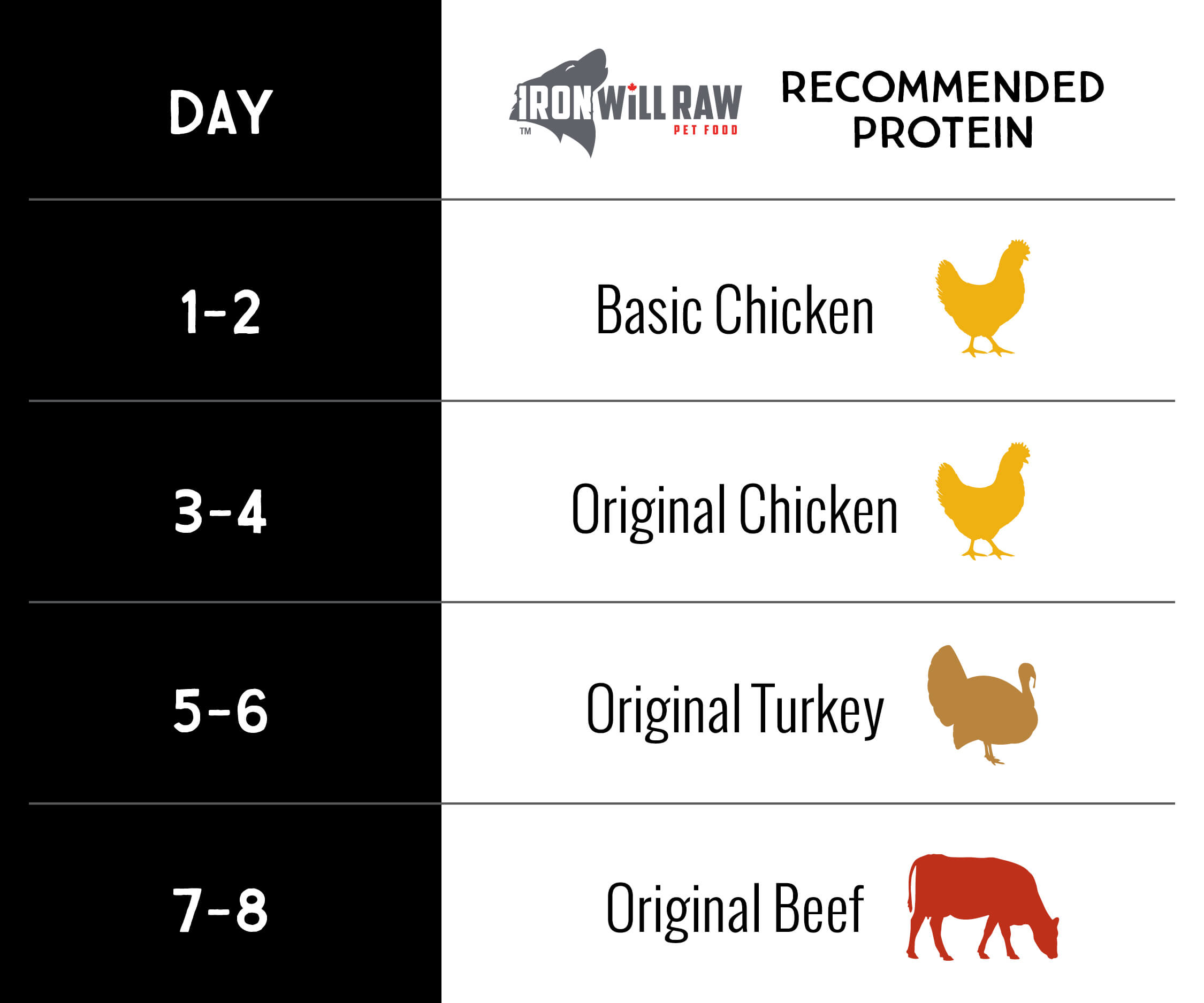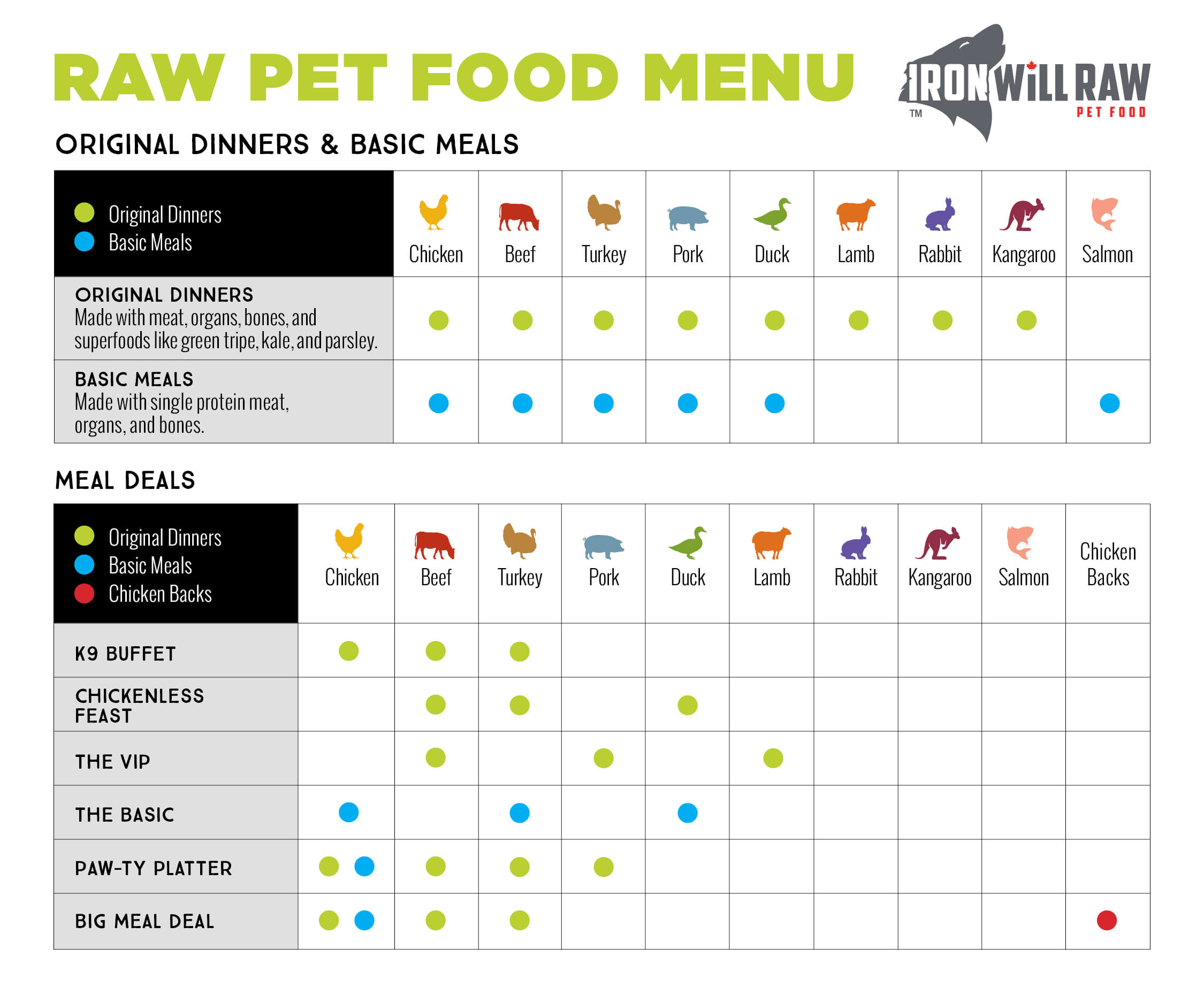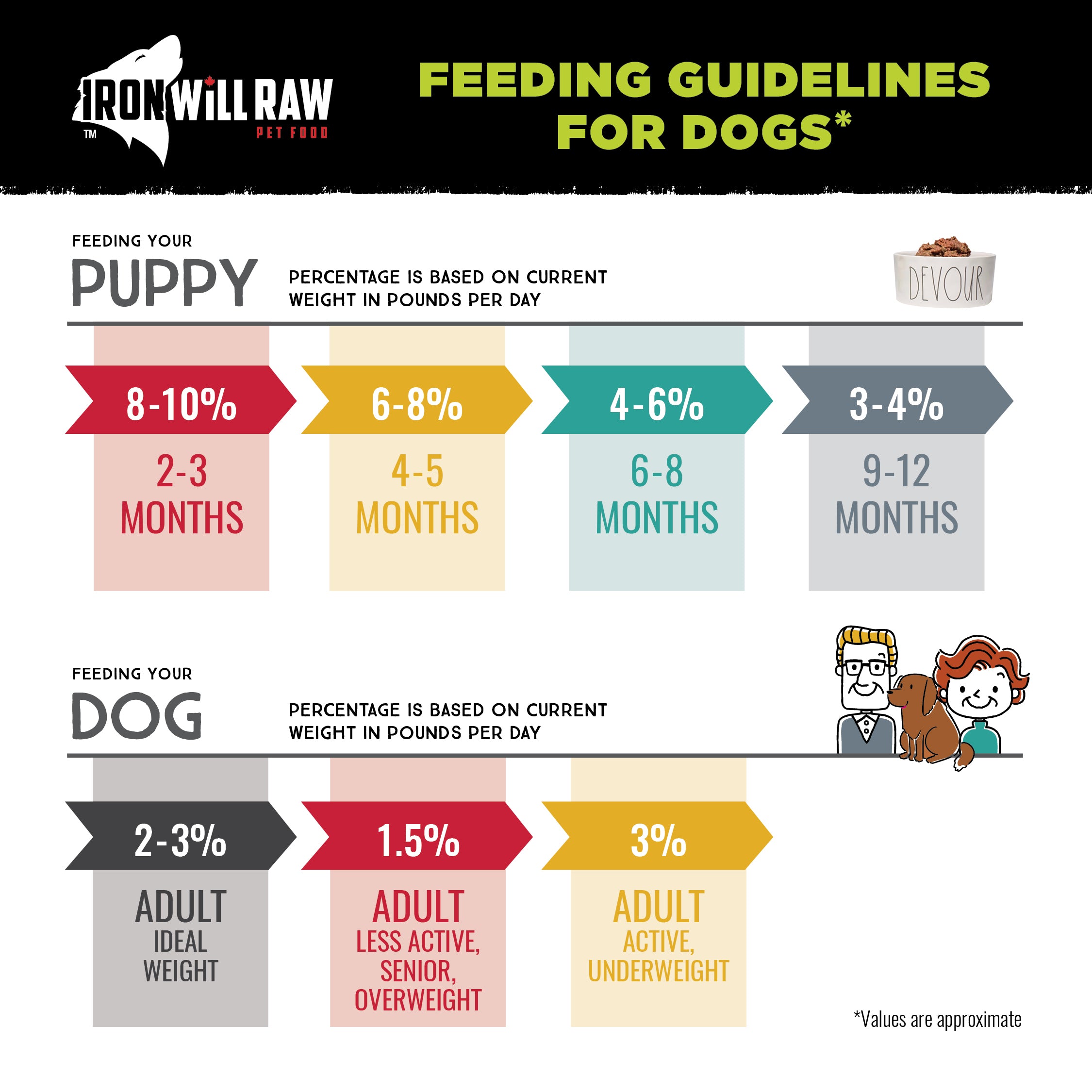How to Transition Dogs to a Raw Diet
How to transition your dog to raw pet food
Switching your dog to a raw pet food diet is one of the best things you can do for their health and overall well being. We recommend feeding puppies a raw dog food diet as soon you bring them home, but puppies aren't the only ones who benefit from being fed a raw pet food diet! Transitioning your adult or senior dog to a raw pet food diet has significant benefits, too. Some benefits will be noticeable right away, while others may take a little more time to show their effect.
How to transition to a raw pet food diet
When making the transition to a raw pet food diet, we recommend starting with an easily digestible protein, such as our Basic Chicken, Basic Turkey, or Basic Duck. After two days of feeding your pet one of these Basic Formulas, try introducing an Iron Will Raw Original Dinner blend with the same protein.
Below are two examples of a transition program:

If your pet has a suspected chicken intolerance, we suggest trying this transitioning schedule instead.

Transitioning Options
- Cold Turkey: We recommend a straight "cold turkey" switch to raw for dogs. This is best achieved by fasting your dog for 12-24 hours and then offering them their first raw meal (see below for temperature). If you have a senior pet, or a pet with a history of digestive upset, try adding a probiotic to their meals prior to transitioning and for the first few weeks on raw. This supports the gut's natural microflora which enhances digestion and absorption of nutrients.
- Gradual: We understand that a straight transition onto raw may not work for some pets or owners. If you need to gradually introduce raw to the bowl that is OK. Here's how we recommend making a "gradual" transition:

Raw Dog Food Feeding Tips
Prior to feeding your pet raw food for the first time, we suggest fasting your dog for 12-24 hours. This gives their body time to digest any leftover food and clear out their gastrointestinal tract, helping allow for a smooth transition to a raw pet food diet.
Eating a cold meal quickly, early in transitioning stage may cause some dogs to throw up. To help ease the transition to a raw pet food diet, we recommend removing your pet's meal portion from the fridge and letting it sit at room temperature for 20-30 minutes before feeding. Each day leave the meal on the counter for 5 minutes less until you pet is eating the food straight from the refrigerator.

Patience may be the best piece of advice we can give you! The first few times you put a bowl of raw food in front of your pet, they may be unsure about it. This is totally normal! Raw dog food is very different compared to the kibble they might be used to. Give your dog 5 to 10 minutes to eat and put any leftovers in the fridge for their next meal. Although adding toppers to your dog's meal may be enticing, we don't recommend doing so as it can teach your dog to wait for something "better" to be offered.
Do I need to add probiotics to my dog's raw food?
Dogs that have been on a diet of kibble for a long time or who have a history of sensitive stomachs can benefit from the addition of probiotic or digestive enzyme supplements. These supplements support the microflora that are naturally present in a dog's gut, enhancing digestion, the absorption of nutrients, and helping boost their immune system. While probiotic or digestive enzyme supplements are great for all dogs to help keep their gastrointestinal tracts healthy, many puppies and young dogs can transition to a raw pet food diet easily without the addition of these enzymes.
After switching your dog to raw pet food, you may notice:
They gulp their food
Well of course they do – it's delicious! Unlike humans, dogs are naturally less inclined to 'chew' their food. Dogs teeth are designed to slice meat into smaller, more manageable bits to swallow. Many dogs do not sit and chew pre-ground formulas. A major concern with gulping food when being fed a dry kibble diet is bloat (gastric torsion). This is very serious and can be fatal to pets. Since kibble has a swell factor (see how much kibble increases in size if you leave it in bowl of water to soak) it can swell in the dog's stomach once it hits the digestive juices and if mixed with excess air (from gulping) can cause the stomach to flip. Since raw food's shape and size does not change with the addition of gastric digestive juices there is less risk of gastric torsion.
They drink less
You may notice your pet drinking less water after switching them to a raw pet food diet. That's because a raw diet provides true, natural hydration. Both kibble and canned food contain higher levels of salt which can leave your pet in a constant state of under-hydration.
There are lots of benefits switching your pet to raw! Here's a few more:

Raw Food Safety Tips for Home
We recommend following the same safety practices that you would for yourself when you bring raw meat into your home. Store Iron Will Raw in the freezer, securely packaged, until it's time to thaw. Storing your pet's raw food in the freezer prevents bacteria growth. Avoid thawing, refreezing, and rethawing raw pet food as this practice can allow bacteria to develop.
To thaw Iron Will Raw, remove the package from the freezer and place it in the fridge to thaw. Once your pet's meal has thawed, portion it and serve. Refer to the guidelines for thawing Iron Will Raw before feeding. Keep all unused portions in the fridge in a sealed container for up to 2-3 days. Bacteria can start growing at 4°C, so make sure your pet's food is being stored at lower temperatures.
When you feed your pet raw food, use stainless steel bowls and utensils that are easy to disinfect. Be sure to wash all surfaces that come in contact with raw pet food with warm soapy water.
Avoid leaving your pet's raw food out for long periods of time, as this can allow bacteria to grow.
If you choose to feed your dog Raw Meaty Bones, feed them on surfaces that can be easily cleaned and disinfected.
About our products
Iron Will Raw pet food is vacuum-sealed in 1lb ready-to-serve portions for your furry friend. Our packaging is 100% recyclable and stores easily in your freezer. Our 1lb pouches have a convenient, easy-peel corner which makes opening your pet's raw food simple and mess-free.
Our raw pet food is available in a wide variety of protein options and we offer two types of raw blends for your pet: Original Dinners and Basic Meals. Our Original Dinners are made with raw meat, organ meat, and bone. They also contain superfoods like green tripe, kale, spinach, parsley, and kelp. Our Basic Meals are made with single protein meat, bones, and organs. That's it! These meals are perfect for pet owners who like to add their own fruit, veggies, or supplements to their dog's bowl. They are also a great option for dogs who need a single protein diet for sensitivities.


How much Iron Will Raw should I feed my dog?
The amount of raw pet food you should feed your dog varies based on their age, activity level, and weight. Feeding your pet the right amount of raw food is essential for their health and nutrition. Feeding puppies the correct amount is instrumental to their growth and development. It is important to note that – especially for puppies – that food requirements change quickly and adjustments must be made based on individual needs, development and diets.
This handy chart provides a guideline for how much raw dog food your pet needs each day:


Check out our Raw Feeding Calculator for more information and menu suggestions.
How to Transition Dogs to a Raw Diet
Source: https://ironwillrawdogfood.com/pages/transition-to-raw
0 Response to "How to Transition Dogs to a Raw Diet"
Post a Comment